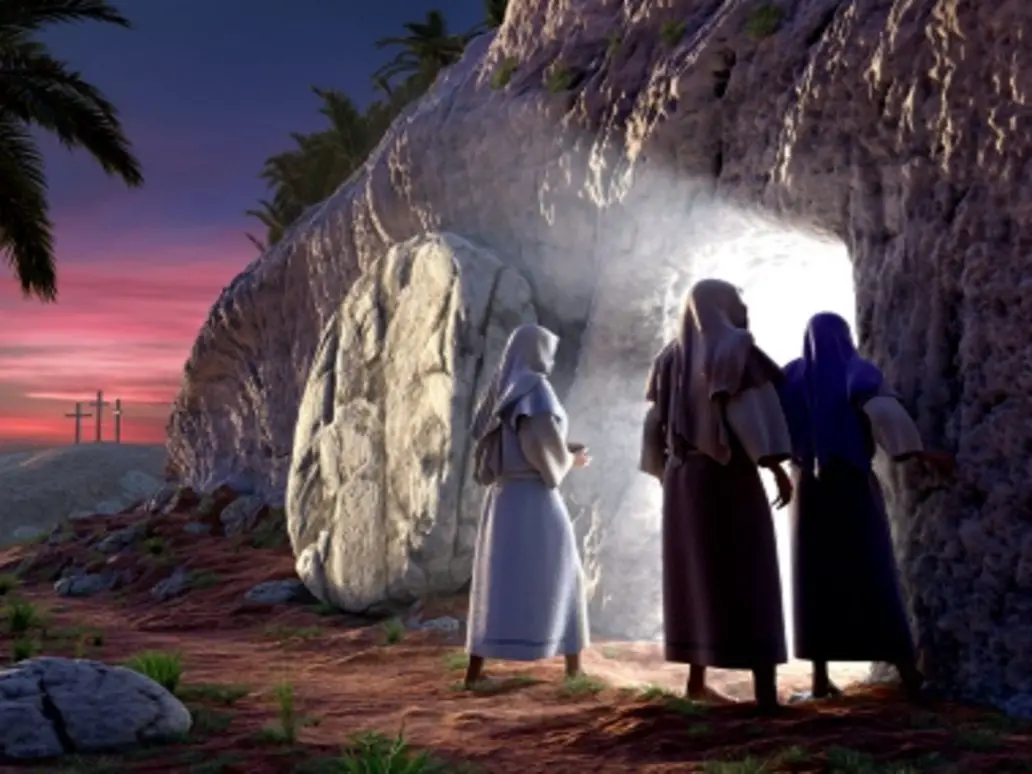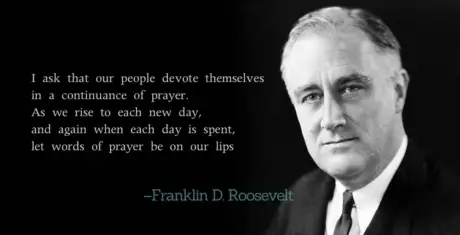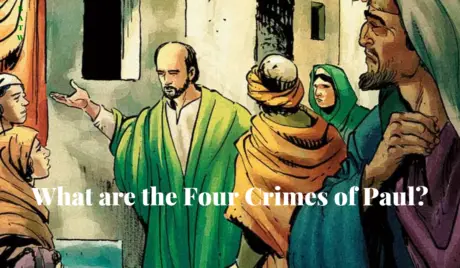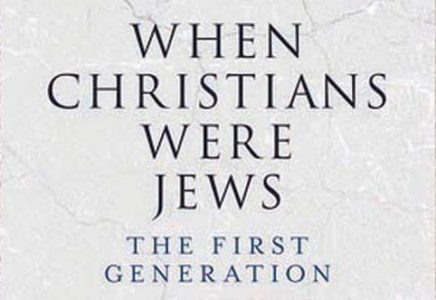What is the Meaning of the Resurrection of Jesus?
Jesus is alive. He’s risen. All the Scriptures of the four Gospels of Jesus Christ point to one thing. However, before I explore this important feature of his resurrection, I want to say this, the resurrection of Jesus Christ is not about Easter.
And Easter is not about his resurrection. So, what is? Read on, for I will definitely explain this!`
“Easter” appears only once in the Bible, but it has no connection to the resurrection of Jesus Christ. See Acts 12:4. Religion combines the two, not the Scriptures!
However, I’m not here to discuss Easter but the resurrection of our Lord and Savior Jesus Christ.
His resurrection is one of the foundational doctrines of Christianity. (Hebrews 6:1-2)
It is proof that he is the embodiment of the “firstfruits” of the dead.
“But now is Christ risen from the dead, and become the firstfruits of them that slept” (1 Corinthians 15:20).
Who Celebrates Easter?
Many Christians around the world primarily celebrate Easter as the most important holiday in the Christian calendar.
However, the exact date of Easter varies from year to year.
Nevertheless, it is always observed on the first Sunday following the first full moon after the vernal equinox, typically falling between late March and late April.
Most Christian denominations, including Catholic, Protestant, Orthodox, and Anglican, celebrate Easter.
But, the First Century Church did not! Jesus and his apostles didn’t celebrate Easter!
However, the traditions and customs associated with the holiday may vary depending on the specific denomination and cultural context.
In addition to Christians, some non-Christian communities and secular cultures also celebrate Easter. They view it as a springtime festival or an occasion to celebrate new beginnings and renewal.
TABLE OF CONTENTS
- What is the Resurrection of Jesus Christ?
- Principle of Future Resurrection
- It’s the Hope of the Rapture
- John’s Account
- Who Celebrates Easter?
- Who Were the Witnesses of the Resurrection of Jesus Christ?
- Ministering Women From Galilee and the Resurrection of Jesus Christ
- Appeared to his Disciples for Forty Days
Who Were the First Witnesses of the Resurrection of Jesus Christ?
According to Matthew, two female followers of Jesus Christ visited his tomb very early in the morning. They were Mary Magdalene and “the other Mary”. Who was the other Mary and why were they at the burial place of Jesus so early in the morning?
Early Sunday morning, just before sunrise, these ladies went to the tomb of Jesus. Listen as the Bible explains.
“In the end of the sabbath, as it began to dawn toward the first day of the week, came Mary Magdalene and the other Mary to see the sepulcher” (Matthew 28:1).
Allow Scriptures to Explain the Resurrection of Jesus Christ
However, as I always advocate, and the Bible bears witness that this is true, allow the Scriptures to explain themselves, for they do!
Observe as Apostle Mark does just that. He clarifies who “the other Mary” is and he supplies the reason for their early visit to Jesus’ tomb.
Up to this point, they were ignorant of what the Scriptures say about Jesus’ resurrection. Therefore, they didn’t expect a risen Jesus, John 20:9.
Apostle Mark agrees with Matthew on this point. Subsequently, he writes:
A Bunch of Marys at the Resurrection of Jesus Christ
“And when the sabbath was past, Mary Magdalene, and Mary the mother of James, and Salome, had bought sweet spices, that they might come and anoint him” (Mark 16:1).
So, they came to prepare the body of Jesus Christ for permanent Jewish-style burial with spices and stuff.
But first, let’s explore the identity of “the Other Mary”, then I will explain in detail for their early-morning visit.
Mark informs us of the identity of “The Other Mary”, for, he writes that she’s “the mother of James”. Additionally, he tells us that there was a third lady there, Salome (Mark 16:1).
See how the Scriptures explain themselves! I didn’t have to guess who those other ladies were because the Bible tells me. It always explains itself!
Ministering Women From Galilee and the Resurrection of Jesus Christ
But that’s not all. The Beloved Physician, Apostle Luke, went a step farther than the two previous apostles.
For he explains that not one, or two ladies, visited the grave of Jesus on the third day, but a group of them.
Therefore, he writes: “Now upon the first day of the week, very early in the morning, they came unto the sepulchre, bringing the spices which they had prepared, and certain others with them” (Luke 24:1).
“They” above refers to the “Women from Galilee”. See Luke 23:55-56 and Mark 15:40-41.
In this instance, the word “they” refers to Mary Magdalene, Mary the mother of James, and Salome. However, “certain others with them” undoubtedly include the other Ministering Women from Galilee which followed Jesus according to Mark.
Come See The Place Where The Lord Lay
Finally, John adds no more details to this account. But he endorses the resurrection account of the other three apostles namely Matthew, Mark, and Luke (John 20:1).
These women came to Jesus’ tomb “that they might come and anoint him”. Recall, I told you these Ministering Women of Jesus Christ were at a distance from the cross, (Luke 23:49).
Consequently, they couldn’t see from their location that Joseph and Nicodemus had already prepared the body of Jesus for burial according to Jewish customs. They didn’t know that. So they came prepared to do so, (Luke 23:55-56 & Luke 24:1).
Who Shall Roll Away the Stone For Us?
As these Ministering Women journeyed to Jesus’ sepulcher, they became concerned. In order to apply the spices that they had brought to the body of Jesus, they must have access to his corpse.
But two days ago, they saw strong men sealed the entrance of the cave with a large stone. Therefore, they were concerned about how to get in.
As a result, they enquired amongst themselves: “Who shall roll us away the stone from the door of the sepulchre?” (Mark 16:3).
But the apostles inform us that they had no need to worry.
“And, behold, there was a great earthquake: for the angel of the Lord descended from heaven, and came and rolled back the stone from the door, and sat upon it” (Matthew 28:2; Mark 16:4; Luke 24:2 & John 20:1).
The Lord God knew the intent of their hearts and made provision for them. He sent His angel to roll away the huge stone.
The Lord Rolled The Stone Away
Therefore, without doubts, we are certain that Jesus died and was buried in the tomb. He wasn’t alive when they buried him.
He was indeed dead for that’s the reason they buried him. Additionally, if he by a very long shot, wasn’t dead and he decided to exit the cave, he couldn’t roll away the “big stone” by himself.
Remember, he was buried alone. Outside his tomb, Roman soldiers were on guard. The stone was so big that not even a group of at least five women could move it. They need assistance to roll it away.
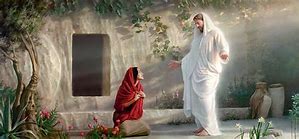
He is Not Here: For He is Risen
But, these women were in for a big surprise. They found Jesus’ sepulcher open. For an angel of God had rolled away the stone that had sealed the tomb and was sitting on it.
On their arrival, they saw Roman Soldiers still securing the tomb. They were very afraid, (Matthew 28:2-4). The angel, however, reassured them and consoled them.
He explained to them, “Fear not ye: for I know that ye seek Jesus, which was crucified” (Matthew 28:5).
Note how he implies that Jesus is no longer dead. He was crucified or dead but he is no longer dead. He’s alive. “He is not here”. Why? Because “he is risen”.
With that declaration of good news, he invited them into the cave. “Come, see the place where the Lord lay” (Matthew 28:6).
Five Things the Angel Told These Women After the Resurrection of Jesus Christ
So, they entered. They saw the empty tomb. But the angel of God wasn’t finished.
He told the women five things:
- Go quickly
- Tell Jesus’ disciples that he is alive and risen
- He travels to Galilee now
- You will see him there
- I told you so
He said, “And go quickly, and tell his disciples that he is risen from the dead; and, behold, he goeth before you into Galilee; there shall ye see him: lo, I have told you” (Matthew 28:7).
Matthew’s account of the resurrection of Jesus Christ, at the tomb, doesn’t focus on physical proofs that he’s alive.
Instead, he zoomed in on other means, such as the angel’s testimony and the women’s witness of the same.
Behold The Place Where They Laid Him
On the other hand, Mark’s account of the resurrection of Christ is not much different from Matthew’s. They follow the identical theme with minor exceptions!
“And he saith unto them, “Be not affrighted: Ye seek Jesus of Nazareth, which was crucified: he is risen; he is not here: behold the place where they laid him” (Mark 16:6).
However, Apostle Mark adopts a similar strategy to Matthew. He too invited the Ministering Women to view the place where Jesus rested.
They All Emphasise “The Place”
But he explains to them six and not five things, Mark 16:6.
But, note how both Apostles Matthew and Mark draw our attention to “the place” where the Lord laid. There’s no corpse. [In criminology, if there is no corpse there is no murder]
Similarly, in the resurrection of Jesus Christ, there is no corpse of him, so he’s not dead.
One noted point of difference between these two accounts is Mark’s emphasis to tell Peter also that Jesus is alive.
“But go your way, tell his disciples and Peter that he goeth before you into Galilee: there shall ye see him, as he said unto you” (Mark 16:7).
Why do You Seek the Living Among the Dead?
While Apostles Matthew and Mark’s accounts of the resurrection of Jesus are pretty similar, Luke’s takes a different trajectory.
First, the Beloved Physician is very bold. This is one of the reasons I love him. He doesn’t mince words. He wrote that the angels asked in a no-none-sense manner:
“Why seek ye the living among the dead?” (Luke 24:5).
So far, he is the only apostle to “explicitly” inform us that Jesus is alive. That’s if you could describe this rhetorical question as direct and explicit.
Second, he employs a technique that I use in every Bible Study. In retrospect, he takes them back to the Scriptures and to the Lord’s actual words to them.
Only Luke Tells Us That Jesus is Alive!
The angel says: “He is not here, but is risen: remember how he spake unto you when he was yet in Galilee, (Luke 24:6).
“Saying, The Son of man must be delivered into the hands of sinful men, and be crucified, and the third day rise again” (Luke 24:7).
When we understand the Word of God, we will believe just like those disciples.
“And they remembered his words” (Luke 24:8).
John’s Account of the Resurrection of Jesus Christ is Different
Nevertheless, speaking of diversity, John’s account of the resurrection of Jesus is like none of the previous descriptions.
He agrees with those accounts before his, that they all saw the place and they believed. But, according to his gospel, the Disciples had no meetings with the angels. But Mary did.
He explains that Mary saw and spoke with the angels unlike any of the disciples.
“But Mary stood without at the sepulchre weeping: and as she wept, she stooped down, and looked into the sepulcher” (John 20:11).
“And seeth two angels in white sitting, the one at the head, and the other at the feet, where the body of Jesus had lain” (John 20:12).
Woman – Why Weepest Thou?
“And they say unto her, Woman, why weepest thou? She saith unto them, Because they have taken away my LORD, and I know not where they have laid him” (John 20:13).
Consequently, he placed Mary Magdalene at the tomb after the disciples. All the other gospels placed her as the first witness of the resurrection of Jesus Christ, but not John.
He explains that after all the disciples left the tomb of Jesus, then Mary saw and interacted with the angels.
“Then the disciples went away again unto their own home” (John 20:10).
John also distinguishes his account of the resurrection of Jesus Christ from all the other apostles’ in another area.
Why Couldn’t Mary Recognize Jesus?
According to Apostle John, and John only, Mary Magdalene is the first and only person who saw and conversed with Jesus very soon after his resurrection.
But, especially in the garden and near to his sepulcher.
She responded to the two angels in Jesus’ tomb then she turned around to leave.
“And when she had thus said, she turned herself back, and saw Jesus standing, and knew not that it was Jesus” (John 20:14).
After the resurrection of Jesus Christ, why couldn’t Mary recognize him?
Then Jesus asked Mary, “Woman, why weepest thou? [W]hom seekest thou? She, supposing him to be the gardener, saith unto him, Sir, if thou have borne him hence, tell me where thou hast laid him, and I will take him away” (John 20:15).
Jesus Instructed Mary – Touch Me Not!
This has great significance. Right now, I don’t why, but I’ll not stop searching the Scriptures until I discover this.
It was so profound that even as Jesus was speaking with Mary she didn’t and couldn’t discern that this was him until….
“Jesus saith unto her, Mary. She turned herself, and saith unto him, Rabboni; which is to say, Master” (John 20:16).
However, it’s what Jesus instructed her not to do and to do, and of his intentions that will guide us to a deeper truth.
“Jesus saith unto her, Touch me not; for I am not yet ascended to my Father: but go to my brethren, and say unto them, I ascend unto my Father, and your Father; and to my God, and your God” (John 20:17).
Conclusion
Why is the Resurrection of Jesus Christ Important?
The resurrection of Jesus Christ proves one thing: He is alive. His burial proves that he indeed died. But his resurrection proves that he is alive. For we bury the dead and the living doesn’t usually live in tombs.
Additionally, Jesus was not in a coma. Based on the Jewish custom of burial, if he were in one, their burial rituals would surely kill him.
First, they applied spices and ointment to the entire body. Then, they wound the body in a linen cloth from head to toe.
When they are done with this bandaging of the body it resembles a caterpillar in a cocoon. This wrapping and bounding of the body would suffocate him if he were comatose.
The Resurrection of Jesus Christ Proves One Thing
Remember Lazarus?
Next, Pilate gave Joseph of Arimathea permission to take the body of Jesus only after a Roman Soldier verified that he was dead.
Do you recall how he did that? I do! He pierced his side with a spear to elicit a response. So, when Jesus didn’t respond (because he was dead) the soldier was certain that he was dead. This he relayed to his leader.
Later, on the same day of his resurrection, in the evening, Jesus utilized the marks from his crucifixion to validate both his death and resurrection.
“Then the same day at evening, being the first day of the week, when the doors were shut where the disciples were assembled for fear of the Jews, came Jesus and stood in the midst, and saith unto them, Peace be unto you” (John 20:19).
“And when he had so said, he shewed unto them his hands and his side. Then were the disciples glad, when they saw the Lord” (John 20:20).
Today, many people would behave similarly to one of Jesus’ disciples, Thomas.
Jesus Christ Our Passover
After the resurrection of Jesus Christ, the first time he appeared to all his disciples at once, but Thomas was absent.
So, he refused to believe that he was alive. He told them he needed evidence that Jesus is alive. And he explained what would convince him of this, (John 20:24-25)
“And after eight days again his disciples were within, and Thomas with them: then came Jesus, the doors being shut, and stood in the midst, and said, Peace be unto you” (John 20:26).
“Then saith he to Thomas, Reach hither thy finger, and behold my hands; and reach hither thy hand, and thrust it into my side: and be not faithless, but believing” (John 20:27).
“And Thomas answered and said unto him, My Lord and my God” (John 20:28).
“Jesus saith unto him, Thomas, because thou hast seen me, thou hast believed: blessed are they that have not seen, and yet have believed” (John 20:29).
Thomas had a revelation of Jesus Christ and it changed his life. Any time we experience one of those it will change our lives too.
He Placed Mary Magdalene at the Tomb After the Disciples
And like Thomas, we and others will know this because we will rambunctiously proclaim, Jesus, My Lord and My God.
Finally, the resurrection of Jesus Christ is not about Easter, but about the Passover, John 19:14.
He is our Passover. He became our Passover. By him, we are saved from death.
“Purge out therefore the old leaven, that ye may be a new lump, as ye are unleavened. For even Christ our passover is sacrificed for us” (1 Corinthians 5:7).
Jesus’ resurrection proves that he conquered death. He’s alive! He’s risen! And he is the only person in the history of humanity to return from the dead after being dead for three days.
Nobody else has done this!
In closing, if you desire more details of how you, as a born-again Christian will conquer death, just like Jesus, read the book that I recommend below.
STUDY QUESTIONS
- What is Pentecost?
- Why is it Important to the Church?
- How has it changed the world?
Updated:-2023-03-07
